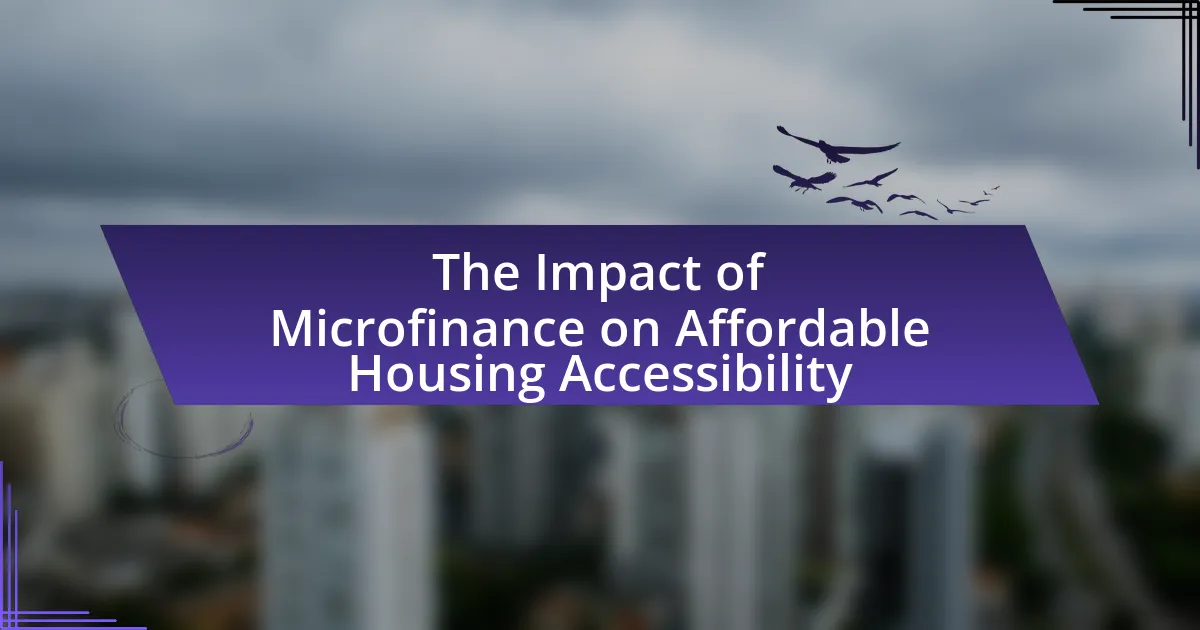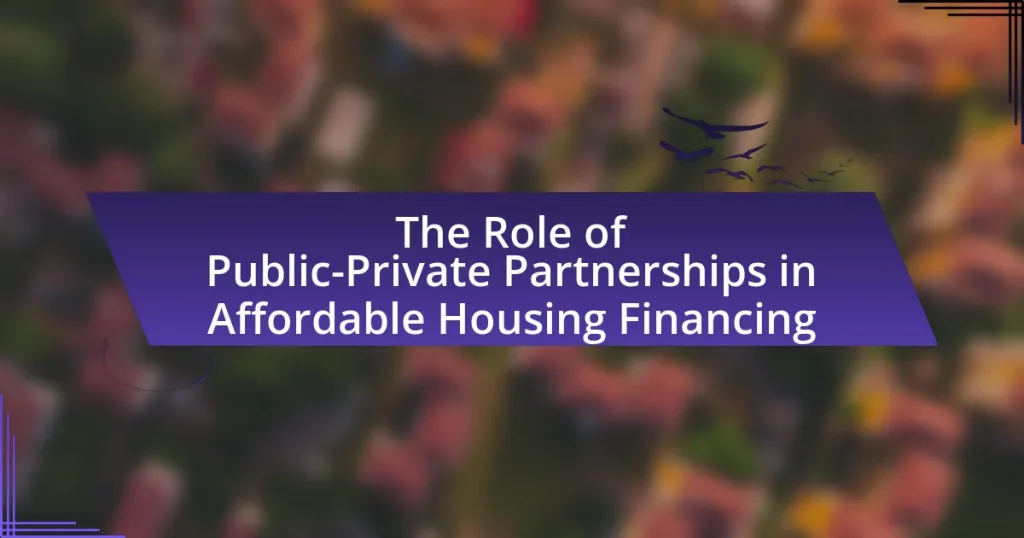Microfinance plays a critical role in enhancing affordable housing accessibility for low-income individuals by providing them with financial resources to secure housing, improve living conditions, and increase homeownership rates. The article examines how microfinance institutions (MFIs) facilitate housing loans, assess housing needs, and address challenges such as high interest rates and inadequate financial literacy. It also explores the impact of regulatory frameworks, innovative models, and technology on microfinance services, highlighting best practices and future trends that can optimize housing accessibility. Overall, the article underscores the importance of microfinance in empowering marginalized communities and contributing to community development through improved housing solutions.
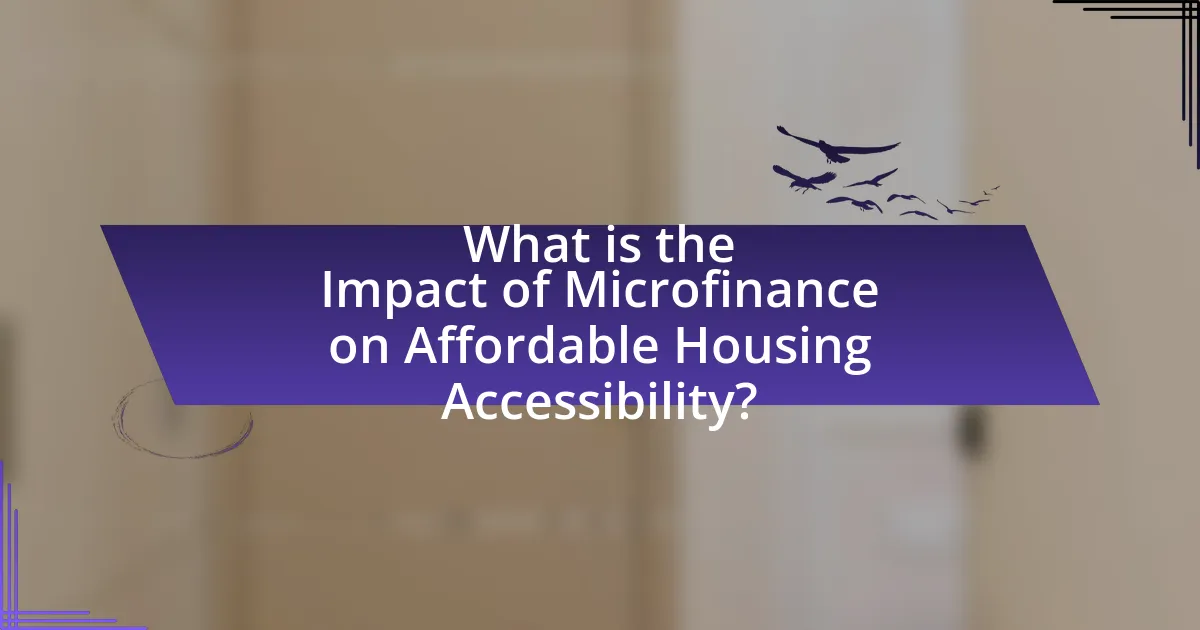
What is the Impact of Microfinance on Affordable Housing Accessibility?
Microfinance significantly enhances affordable housing accessibility by providing low-income individuals with the necessary financial resources to secure housing. This financial support enables borrowers to invest in housing improvements, purchase land, or construct homes, which would otherwise be unattainable due to limited access to traditional banking services. For instance, a study by the Consultative Group to Assist the Poor (CGAP) found that microfinance institutions (MFIs) have successfully facilitated housing loans, leading to improved living conditions for over 100 million people globally. Additionally, research published in the Journal of Housing Studies indicates that microfinance can reduce the housing deficit in developing countries by empowering marginalized communities to invest in their housing needs.
How does microfinance contribute to affordable housing solutions?
Microfinance contributes to affordable housing solutions by providing low-income individuals with access to small loans specifically designed for housing improvements or construction. These financial services enable borrowers to invest in their living conditions, which can lead to better housing quality and increased homeownership rates. For instance, a study by the Consultative Group to Assist the Poor (CGAP) found that microfinance institutions have successfully financed over 1.5 million housing loans globally, demonstrating the effectiveness of microfinance in addressing housing needs. By facilitating access to capital, microfinance empowers marginalized communities to secure safe and affordable housing, thereby enhancing their overall living standards.
What are the key features of microfinance that support housing accessibility?
Microfinance supports housing accessibility through features such as small loan amounts, flexible repayment terms, and community-based lending. Small loan amounts enable low-income individuals to secure funding for housing improvements or purchases that traditional banks may deem too risky. Flexible repayment terms allow borrowers to align payments with their income cycles, making it easier for them to manage their finances. Community-based lending fosters trust and accountability, as borrowers often come from the same social networks, which can enhance repayment rates and encourage collective investment in housing. These features collectively contribute to increased housing accessibility for underserved populations.
How do microfinance institutions assess housing needs?
Microfinance institutions assess housing needs through a combination of community surveys, individual assessments, and analysis of local housing markets. They typically conduct surveys to gather data on the living conditions, financial capabilities, and specific housing requirements of potential clients. This information is complemented by individual assessments that evaluate the borrower’s income, credit history, and repayment capacity. Additionally, microfinance institutions analyze local housing market trends to understand the availability and affordability of housing options. This multi-faceted approach ensures that the institutions can tailor their financial products to meet the specific housing needs of low-income families, thereby enhancing access to affordable housing.
What challenges does microfinance face in promoting affordable housing?
Microfinance faces several challenges in promoting affordable housing, primarily including high interest rates, limited loan amounts, and inadequate financial literacy among borrowers. High interest rates can deter potential clients from accessing loans, as they may find repayment burdensome. Limited loan amounts restrict borrowers from financing comprehensive housing solutions, often resulting in incomplete or substandard housing. Additionally, inadequate financial literacy among potential borrowers can lead to poor financial decisions, further complicating their ability to secure and manage housing loans effectively. These factors collectively hinder the effectiveness of microfinance in addressing the affordable housing crisis.
What are the common barriers to accessing microfinance for housing?
Common barriers to accessing microfinance for housing include lack of collateral, high interest rates, limited financial literacy, and inadequate regulatory frameworks. Lack of collateral prevents many low-income individuals from securing loans, as microfinance institutions often require some form of asset to guarantee repayment. High interest rates can deter potential borrowers, making loans unaffordable despite the availability of funds. Limited financial literacy among potential borrowers leads to misunderstandings about loan terms and repayment schedules, further complicating access. Additionally, inadequate regulatory frameworks can hinder the growth of microfinance institutions, limiting their ability to serve low-income populations effectively. These barriers collectively restrict access to microfinance for housing, impacting affordable housing accessibility.
How do regulatory frameworks impact microfinance and housing accessibility?
Regulatory frameworks significantly influence microfinance and housing accessibility by establishing the legal and operational parameters within which microfinance institutions (MFIs) operate. These frameworks can either facilitate or hinder access to financial services for low-income individuals seeking housing solutions. For instance, regulations that promote transparency and consumer protection can enhance trust in MFIs, leading to increased participation from borrowers. Conversely, overly stringent regulations may limit the ability of MFIs to lend, thereby restricting access to affordable housing finance. Evidence from the World Bank indicates that countries with supportive regulatory environments for microfinance see higher rates of loan disbursement to underserved populations, which directly correlates with improved housing accessibility.
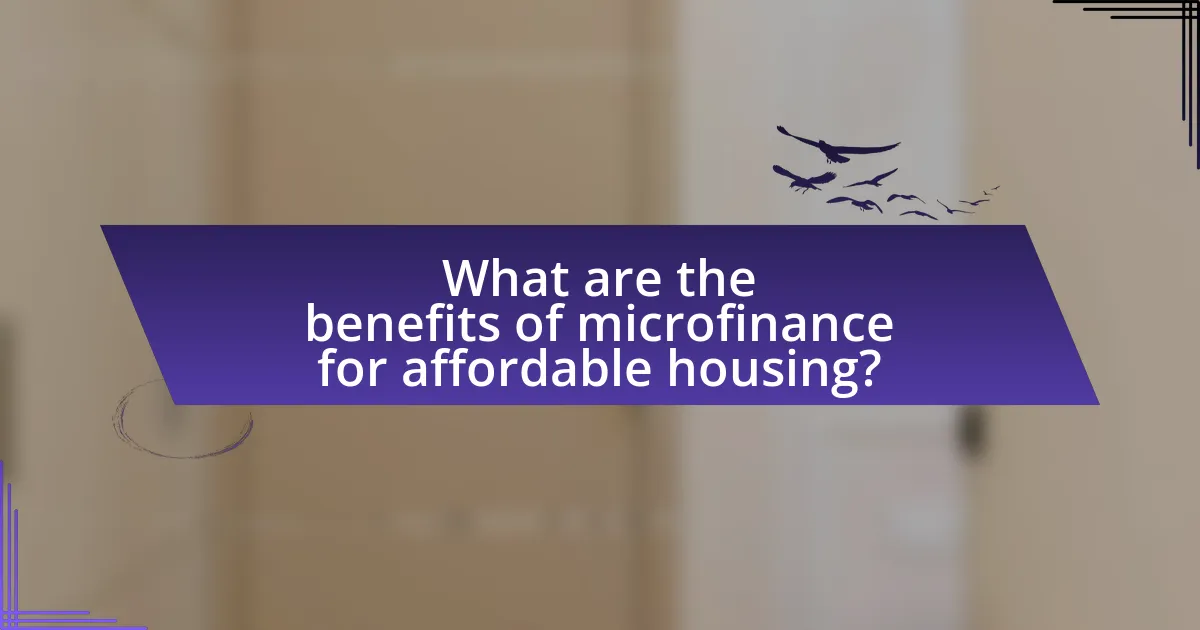
What are the benefits of microfinance for affordable housing?
Microfinance provides essential financial services that enhance access to affordable housing for low-income individuals. By offering small loans, microfinance institutions enable borrowers to finance home construction or improvement, which is often unattainable through traditional banking systems due to lack of collateral or credit history.
Research indicates that microfinance can significantly increase home ownership rates among low-income populations. For instance, a study by the Consultative Group to Assist the Poor (CGAP) found that microfinance clients were 30% more likely to invest in housing improvements compared to non-clients. Additionally, microfinance fosters community development by encouraging local employment through construction projects, thereby stimulating economic growth in underserved areas.
These benefits collectively contribute to improved living conditions, increased property values, and enhanced social stability, demonstrating the critical role of microfinance in promoting affordable housing solutions.
How does microfinance empower low-income families in housing?
Microfinance empowers low-income families in housing by providing them with access to small loans that enable them to purchase, build, or improve their homes. These financial services are tailored to meet the needs of families who typically lack collateral and credit history, allowing them to invest in housing solutions that would otherwise be unattainable. For instance, a study by the Consultative Group to Assist the Poor (CGAP) found that microfinance institutions have successfully facilitated home ownership for millions of families, leading to improved living conditions and increased economic stability. This access to finance not only helps families secure housing but also fosters community development and enhances overall quality of life.
What role does microfinance play in improving living conditions?
Microfinance plays a crucial role in improving living conditions by providing low-income individuals access to financial services, enabling them to invest in housing and essential needs. By offering small loans, microfinance institutions empower borrowers to build or upgrade their homes, which directly enhances their living environments. For instance, a study by the Consultative Group to Assist the Poor (CGAP) found that microfinance clients often use loans for housing improvements, leading to better sanitation and increased safety. This financial support not only facilitates immediate housing upgrades but also contributes to long-term economic stability, as improved living conditions can enhance health outcomes and educational opportunities for families.
How does microfinance facilitate community development through housing?
Microfinance facilitates community development through housing by providing low-income individuals and families access to affordable loans for home construction and improvement. This financial support enables beneficiaries to build or enhance their living conditions, which in turn fosters community stability and growth. For instance, a study by the Consultative Group to Assist the Poor (CGAP) found that microfinance initiatives have led to improved housing quality and increased property values in communities where such programs are implemented. Additionally, access to housing finance encourages local economic activity, as families invest in their homes and contribute to the local economy, creating jobs and enhancing overall community welfare.
What economic impacts does microfinance have on housing markets?
Microfinance positively impacts housing markets by increasing access to affordable housing for low-income individuals. By providing small loans, microfinance institutions enable borrowers to invest in housing improvements or purchase homes, which stimulates local economies. For instance, a study by the Consultative Group to Assist the Poor found that microfinance can lead to a 20% increase in housing quality among borrowers, enhancing property values in surrounding areas. Additionally, increased home ownership through microfinance contributes to community stability and economic growth, as homeowners are more likely to invest in their neighborhoods.
How does microfinance influence property values in low-income areas?
Microfinance positively influences property values in low-income areas by providing access to capital for home improvements and business development. This access enables residents to enhance their properties, leading to increased demand and higher property values. For instance, a study by the Consultative Group to Assist the Poor (CGAP) found that microfinance initiatives can lead to a 20% increase in property values as homeowners invest in renovations and maintenance. Additionally, improved economic conditions from microfinance-supported businesses contribute to neighborhood revitalization, further elevating property values.
What is the relationship between microfinance and local employment opportunities?
Microfinance positively influences local employment opportunities by providing small loans to entrepreneurs who may lack access to traditional banking services. These loans enable individuals to start or expand small businesses, which in turn creates jobs within the community. For instance, a study by the Consultative Group to Assist the Poor (CGAP) found that microfinance initiatives can lead to a 20% increase in employment rates in areas where such services are available. This relationship demonstrates that microfinance not only supports individual economic growth but also contributes to broader community development through job creation.
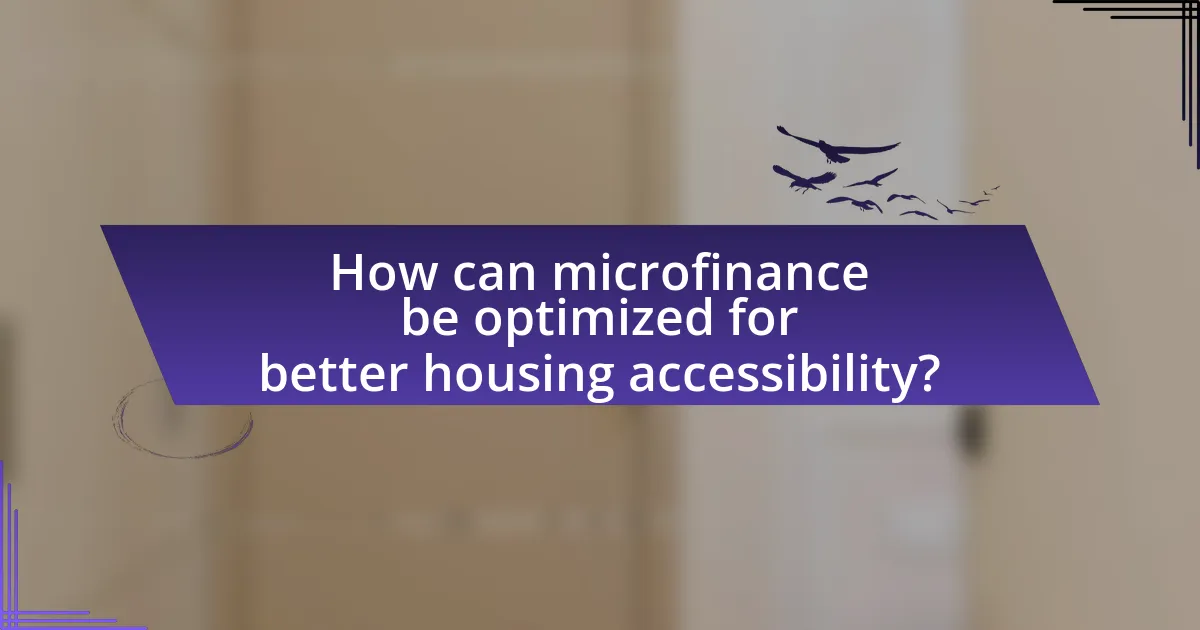
How can microfinance be optimized for better housing accessibility?
Microfinance can be optimized for better housing accessibility by tailoring loan products to meet the specific needs of low-income households. This includes offering smaller loan amounts with flexible repayment terms that align with the income patterns of borrowers, which can enhance their ability to invest in housing improvements or purchase homes. Research indicates that microfinance institutions (MFIs) that provide housing-specific loans, such as those for construction or renovation, have seen increased borrower satisfaction and improved housing conditions. For example, a study by the Consultative Group to Assist the Poor (CGAP) found that targeted microfinance products can lead to a 30% increase in housing quality among beneficiaries. Additionally, integrating financial literacy programs can empower borrowers to make informed decisions about their housing investments, further optimizing the impact of microfinance on housing accessibility.
What innovative models exist for microfinance in housing?
Innovative models for microfinance in housing include community-based financing, housing microloans, and savings-led approaches. Community-based financing involves local groups pooling resources to provide loans for housing improvements, fostering trust and accountability among members. Housing microloans are small, targeted loans specifically designed for low-income individuals to build or improve their homes, often with flexible repayment terms that accommodate borrowers’ income cycles. Savings-led approaches encourage individuals to save for housing needs, with financial institutions matching savings or providing loans based on savings history, promoting financial discipline and ownership. These models have been shown to increase access to affordable housing, as evidenced by programs in countries like Bangladesh and India, where microfinance initiatives have successfully improved living conditions for low-income families.
How can technology enhance microfinance services for housing?
Technology can enhance microfinance services for housing by improving access to financial data, streamlining loan processing, and facilitating communication between lenders and borrowers. Digital platforms enable microfinance institutions to assess creditworthiness through alternative data sources, such as mobile payment histories and social media activity, which can increase loan approval rates for underserved populations. Additionally, mobile banking applications allow borrowers to manage their loans and make payments conveniently, reducing transaction costs and improving repayment rates. According to a report by the Consultative Group to Assist the Poor, the use of technology in microfinance has led to a 20% increase in loan disbursement efficiency, demonstrating its effectiveness in enhancing housing finance accessibility.
What partnerships can strengthen microfinance initiatives for housing?
Partnerships with local governments, non-governmental organizations (NGOs), and construction firms can significantly strengthen microfinance initiatives for housing. Local governments can provide regulatory support and land access, facilitating the development of affordable housing projects. NGOs often bring expertise in community engagement and can help identify the specific needs of low-income populations, ensuring that microfinance products are tailored effectively. Collaborations with construction firms can lead to cost-effective building solutions and innovative housing designs, enhancing the overall impact of microfinance on housing accessibility. For instance, partnerships with Habitat for Humanity have demonstrated success in leveraging microfinance to improve housing conditions for low-income families, showcasing the effectiveness of such collaborations.
What best practices should be followed in microfinance for housing?
Best practices in microfinance for housing include offering tailored loan products, ensuring transparent communication, and providing financial literacy training. Tailored loan products address the specific needs of low-income households, allowing for flexible repayment terms and amounts that align with their income patterns. Transparent communication fosters trust and helps borrowers understand the terms and conditions of their loans, reducing the risk of default. Financial literacy training equips borrowers with essential skills to manage their finances effectively, which can lead to better repayment rates and improved housing outcomes. Research indicates that microfinance institutions that implement these practices see higher rates of successful housing projects and improved living conditions for borrowers.
How can microfinance institutions improve outreach to underserved populations?
Microfinance institutions can improve outreach to underserved populations by leveraging technology to enhance accessibility and streamline services. For instance, mobile banking applications allow clients in remote areas to access financial services without the need for physical branches, which are often lacking in underserved regions. According to the Global Financial Inclusion Index, mobile money services have increased financial access for over 1.6 billion people globally, demonstrating the effectiveness of technology in reaching marginalized communities. Additionally, partnerships with local organizations can help microfinance institutions better understand the specific needs of these populations, tailoring products and services accordingly. This approach has been shown to increase loan uptake and repayment rates, as evidenced by a study from the Consultative Group to Assist the Poor, which found that targeted outreach efforts significantly improved financial inclusion among low-income households.
What strategies can ensure sustainable microfinance for housing projects?
Sustainable microfinance for housing projects can be ensured through a combination of risk assessment, community involvement, and tailored financial products. Risk assessment involves evaluating borrowers’ repayment capabilities and property values to minimize defaults, as evidenced by studies showing that thorough assessments lead to lower default rates. Community involvement fosters trust and encourages local participation in project planning, which has been shown to enhance project sustainability and borrower commitment. Tailored financial products, such as flexible repayment schedules and micro-loans specifically designed for housing, address the unique needs of low-income families, thereby increasing access to affordable housing. These strategies collectively contribute to the long-term viability of microfinance initiatives in the housing sector.
What are the future trends in microfinance and affordable housing?
Future trends in microfinance and affordable housing include the integration of technology, increased focus on sustainability, and the expansion of financial inclusion. The use of digital platforms for microfinance is expected to streamline loan processes, making it easier for low-income individuals to access funds for housing. According to a report by the Consultative Group to Assist the Poor (CGAP), digital financial services can reduce transaction costs and improve outreach to underserved populations. Additionally, there is a growing emphasis on environmentally sustainable housing solutions, as seen in initiatives that promote green building practices within microfinance frameworks. The World Bank highlights that sustainable housing can enhance resilience against climate change while providing affordable options. Lastly, the trend towards financial inclusion is supported by various governments and NGOs, aiming to provide microfinance services to marginalized communities, thereby increasing access to affordable housing.
How might policy changes affect microfinance and housing accessibility?
Policy changes can significantly impact microfinance and housing accessibility by altering regulatory frameworks, funding availability, and interest rates. For instance, if a government implements policies that increase funding for microfinance institutions, these entities may offer more loans to low-income individuals, thereby enhancing access to affordable housing. Conversely, stricter regulations on lending practices could limit the ability of microfinance institutions to provide loans, reducing housing accessibility. Historical data shows that in countries like Bangladesh, policy reforms that supported microfinance led to a 20% increase in home ownership among low-income families, demonstrating the direct correlation between policy changes and housing accessibility through microfinance.
What role will digital finance play in the future of affordable housing?
Digital finance will play a crucial role in enhancing access to affordable housing by streamlining financing processes and reducing costs for both borrowers and lenders. Through technologies such as blockchain and mobile banking, digital finance can facilitate quicker loan approvals, lower transaction fees, and improved transparency in lending practices. For instance, a report by the World Bank indicates that digital financial services can increase access to credit for low-income individuals, which is essential for purchasing or improving housing. Furthermore, platforms that utilize data analytics can assess creditworthiness more accurately, enabling more people to qualify for loans that were previously inaccessible.
